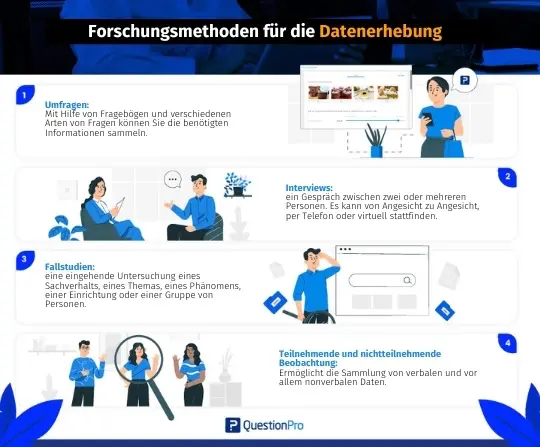Online Community
Research methods are a key element in building valid knowledge about a particular phenomenon. Therefore, it is fundamental for every researcher to know what they consist of, what characteristics they have and what the choice of one or another method depends on.
For this reason, in this article we will provide a general introduction to the topic for those interested in a science, field or social discipline, including its relationship to methodology, research directions, techniques, tools and some examples of its use Methods in research.
CONTENT
- 1 What are research methods?
- 2 Difference between method and methodology
- 3 Types of research methods
- 4 How to choose the right research method?
- 5 Examples of research methods for data collection
- 6 Research methods for data analysis
- 7 Start your research!
- 8 1:1 Live Online Presentation: QuestionPro Online Community Software
- 9 Try software for market research and experience management now for 10 days free of charge!
What are research methods?
Research methods are defined as the set of techniques that, combined with the direction of an investigation and the use of specific instruments, make it possible to achieve a specific product or result.
The researcher who is clear about his direction knows that a number of methods are available to him, but he also knows that the use of one method or another (or the combination of several methods) leads to a very specific result becomes and not to another.
Difference between method and methodology
Research methodology is the set of coherent, general and abstract decisions that the researcher makes about how to obtain certain types of data from the reality he is studying, but which are objectively reflected in the way he approaches reality approaches and obtains data from it with the help of methods, techniques and instruments.
Research methods are the strategies, processes, or techniques used in collecting data or evidence for analysis to discover new information or create a better understanding of a topic.
Types of research methods
There are two major types of research and methods that can be used in research: qualitative and quantitative research methods. The former also belong to the descriptive methods, the latter to the interpretive methods.
Quantitative method
Quantitative research involves quantifiable or numerical data (quantities, orders of magnitude), which is why we work with very large populations (for which representative samples are used as validation criteria).
It collects numerical data that can be classified, measured, or categorized through statistical analysis, helping to discover patterns and relationships and make generalizations.
Qualitative method
In qualitative research, the causes of phenomena are sought in the depth of the subjects' interpretations of these phenomena, so that sometimes very small parts of subjects or materials are worked on (sometimes using so-called “saturation sampling”).
The qualitative orientation allows researchers to gain a better understanding of complex processes, social interactions, or cultural phenomena by collecting data about lived experiences, emotions, or behaviors and the meanings individuals associate with them.
Mixed methods research
The Mixed methods research integrates both quantitative and qualitative research, providing a holistic approach that combines and analyses statistical data with contextual insights at a deeper level.
These are by no means opposing perspectives, but rather highly complementary forms of knowledge production, and work is increasingly being found that supports qualitative research in the production of quantitative data and vice versa.
How to choose the right research method?
The choice of research method largely depends on which questions you want to answer as part of your research. This determines the direction of the work and thus also the strategies, techniques and instruments for obtaining valid insights.
The choice of a quantitative method responds to the need to draw generalizable conclusions about the phenomena you analyse, and not about the specifics of their “meaning”. Therefore, this type of research is useful for finding out how much, how often, or to what extent a particular phenomenon occurs.
Choosing a qualitative method makes it possible to make use of the “perceptions” of the people being studied, that is, the “qualities” of the world that emerge from the people's representations, and is therefore useful for examining how or why things happened , interpret events and describe actions.
Examples of research methods for data collection
There are various methods of data collection in both qualitative and quantitative research, including:
Survey
Surveys collect information using questionnaires. They are usually carried out with large groups of people, but other techniques such as interviews or telephone calls can also be used.
There are different types of surveys such as: E.g.:
- The one-topic survey. They are the most direct form and are carried out on a sample of people at a specific point in time.
- Before and after. These surveys are completed by people before and after an important event or experience.
As for survey tools, you can use an online survey platform that leverages digital platforms such as email and social media, or an offline survey platform if you are conducting fieldwork in an area without internet access.
Surveys
Interviews are typically conducted in person, but can also be conducted over the phone or a video calling platform. Sometimes they are carried out in the respondents' homes, sometimes in a more neutral location.
The interviewer (who is not necessarily the researcher) may adopt a formal or informal tone and use structured, semi-structured, or unstructured interview approaches.
Case studies
The Case studies it is the detailed investigation of a specific case (an individual or a small group). Various methods of data collection and analysis are used, but these typically involve observation and interviewing and may include interviewing other people or public records.
Researchers may be interested in a particular phenomenon and select one or more people in that situation on which to base their case studies.
They usually result in very detailed and descriptive data that apply only to the case under investigation. But they can also challenge existing theories and practices in the field.
Participant and non-participant observation
Studies that involve observing people can be divided into two broad categories: participant observation and non-participant observation.
Participating observation
In participant observation, the researcher becomes part of the group being observed. That's what it takes to belong Trust of group members to gain and at the same time maintain sufficient distance to be able to carry out the observation.
These observations may relate to what people do, to the reasons they give for their actions, to the roles they take, to the relationships that exist between them, and to the characteristics of the situation in which they are located.
The researcher should talk openly about what they are doing, give study participants the opportunity to see and comment on the results, and take their comments seriously.
Non-participant observation
In non-participant observational studies, the researcher is not part of the group being studied. The researcher decides in advance what types of behaviors are relevant to the study and can be realistically and ethically observed.
Observation can be carried out in different ways. For example, it can occur continuously over a certain period of time (e.g. one hour) or regularly over shorter periods of time (60 seconds at irregular intervals) or randomly.
Observation involves not only noting what happened or was said, but also that a particular behavior had not yet occurred at the time of observation.
Research methods for data analysis
Once you have collected data, you need to work with data analysis methods. The choice of methods for analyzing research data depends on the type of data collected and the way the data is prepared for analysis.
Apart from the choice of method, the data can be analysed both quantitatively and qualitatively. For example, survey responses can be analysed qualitatively by examining the meaning of the responses, or quantitatively by examining the frequency of responses.
Qualitative analysis methods
They are used to understand words, ideas and experiences. It can be used to interpret information obtained from open-ended questions in surveys and interviews, from literature reviews, case studies and other sources that use text rather than numbers, and from non-risk sampling techniques.
Qualitative analysis tends to be flexible and dependent on the researcher's judgment, so you must carefully consider your decisions and assumptions.
Quantitative analysis method
This analysis uses numbers and statistics to understand frequencies, averages, and correlations (in descriptive studies) or cause-and-effect relationships (in experiments).
Quantitative data analysis can be used to interpret data collected either as part of an experiment or using probability sampling techniques because the data is collected and analysed in a valid statistical form.
Start your research!
Your customers are real people. Your needs, concerns, and motivations are dynamic and can change quickly due to various situations such as layoffs, budget cuts, and general concerns about the state of the economy.
Now more than ever, you need to know what your customers think every day, what they need, what they want, what motivates them, how economic changes have affected them, and what they are willing to buy when things improve. This knowledge is crucial to protect yourself from economic downturns, and not only that, it can also lead to success when such situations pass.
The good news is that despite difficult economic times, many companies are recognizing the importance of focusing on market research and have begun to consider new research methods to engage with customers to learn and achieve results without drastically increasing their budgets.
Now that you know what a research method is and what aspects to consider when choosing a method and starting your work, it is time for you to familiarize yourself with the different tools available to you to to achieve better results.
That's why we invite you to get to know QuestionPro's online survey platform, which allows you to collect information in a simple and practical way. Simply create your free account using the link below or request a demo so one of our consultants can show you the platform's full potential!
1:1 live online presentation:
QuestionPro online community software
Arrange an individual appointment and discover our community software.
Try software for market research and experience management now for 10 days free of charge!
Do you have any questions about the content of this blog? Simply contact us via contact form. We look forward to a dialogue with you! You too can test QuestionPro for 10 days free of charge and without risk in depth!
Test the agile market research and experience management platform for qualitative and quantitative data collection and data analysis from QuestionPro for 10 days free of charge
FURTHER KEYWORDS
SHARE THIS ARTICLE
KEYWORDS OF THIS BLOG POST
Research methods | Research | Methods




